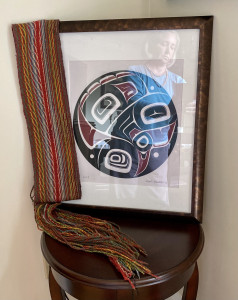There was a time when the Indigenous connections within my family were not discussed, as if they were somehow shameful. This reflects a dark period not only in my family’s history but also in Canada’s history. I now feel ashamed of this history and would like to set things right for my family, my children, and my children’s children.
My husband is Métis, a citizen of the Métis Nation of BC. My children – Lauren, Ally, and Jack – are also Métis. One of the best gifts I ever gave my husband was an original Métis sash worn by a Métis man in the 1800s, partly as a back brace to protect his spine while portaging canoes. My husband’s grandmother’s family originally came from the Red River Valley in Manitoba and then, by way of Saul Saint Marie, settled on Mackinac Island. The men in this family were translators for the “Indian Agency,” proficient in English, French, and Ojibwe. They made their livelihood on fishing and trapping and their children attended a residential school on Mackinac island. I believe these children had a comparatively easier experience than many did in Canadian residential schools. My husband’s great-grandmother was first a student at this school, then became a teacher, and later married one of her students — my husband’s great-grandfather. However, there is much sadness in this story. When my children’s great- grandmother was elderly and sick, she was denied a spot in a Canadian hospital due to her Indigenous status and was sent to the White Earth Indian Reservation in Minnesota to spend her final days.
There’s an unusual twist to this family story-the surname of this family was Waechter, with the European great-great-grandfather having come from what is now Switzerland. My mother’s surname was also Waechter. Her Waechter family line originally came from what is now French Alsace. My mother’s family were settlers, first on the lands of the Oceti Sakowin, meaning Seven Council Fires, the proper name for the people referred to as Sioux. They then homesteaded in Northern Alberta on Treaty 6 territory, a traditional gathering place for diverse Indigenous peoples including the Cree, Blackfoot, Métis, Nakota Sioux, Iroquois, Dene, Ojibway/Saulteaux/Anishinaabe, and the Inuit. My Uncle Milton, my mother’s older brother, worked the land as did my grandfather- both as a trapper and as a logger. He made a family with my Aunty Kathy, who was from the Gitsan Nation, Gutginuxw (Owl) House, and the Gisgaast (Fireweed) Clan. Together, they had three children. When I was a child, I spent a great deal of time with my cousins Martin and Shane but less time with my cousin Cheryl. I am proud to acknowledge that my cousin Cheryl is now Dr. Cheryl Aro and a fellow colleague of mine at the University of Victoria.
My cousin Cheryl has a son, and my cousin Martin had two beautiful daughters. These daughters initially carried the surname Waechter as well. I look forward to getting to know my second cousins. It is interesting how history weaves itself together.
My cousin Martin Waechter has passed away. He was an amazing artist who studied at the Frieda Diesing School of Art in Hazelton. I was gifted a print of his art, which proudly hangs in the Parkside MindKey Health Clinic. I share this artwork with you here, as well as the ancient Métis sash I gifted my husband.
I am proud of my family’s Indigenous roots and connections. I honour the Indigenous people on whose land I now live and work — the lək̓ʷəŋən (Songhees and Esquimalt) Peoples on whose territory the university stands, and the lək̓ʷəŋən and WSANEC Peoples. MindKey Health is dedicated to providing a healing space that honours all the Indigenous histories of Canada.

By Dr. Jillian Roberts in collaboration with Stephen Roberts (Co-Owners of MindKey Health)
